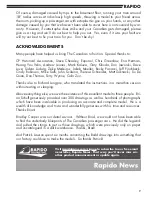
5
pipe, and the bottom of the “V” should be directed toward the centre of the car; i.e.
the steam connector is directly below the coupler box. The preferred adhesive is Mi-
croscale’s Micro Prep and Micro Bond system. This is the only commercially-available
glue that will adequately glue these parts permanently. Full information is available at
microscale.com. You can use CA, but if you have any tunnels you know that’s where the
steam connectors will fall off.
POWERING THE F9B LOCOMOTIVE
We are producing a CN F9B locomotive which will have the same chassis as the CP
F9B. We will make a powered chassis (with and without sound) available separately.
That will be a direct replacement for the unpowered chassis on your CP F9B. We sug-
gest waiting for our powered F9B chassis to be released. The two powered FP9As
should have no trouble hauling a 10-13 car train on their own.
OPERATING THE F9B AND PASSENGER CAR LIGHTS
The F9B is equipped with track-powered LED backup lights on both ends. To turn one
end’s backup light on, wave the Rapido Lighter magnetic wand over the F9B roof near
that end of the unit. Once the Lighter gets close to the hidden reed switch, the light will
turn on. Waving the wand over the switch will turn it off.
Unlike our Super Continental Line passenger cars, the cars of The Canadian are equipped
with track-powered interior and marker/drumhead lights. They work equally well on DC-
and DCC- equipped layouts. We made a conscious decision to go with track-powered
lighting early into the development process as the shell is a one-piece casting, and there
aren’t any logical locations to put batteries underneath the car. The interior lights are all
surface-mount LEDs, and so have an extremely low power draw.
In addition to the interior lighting, the Park Car of your Canadian also has working
marker lights and a working drumhead. They can be turned on and off using the in-
cluded Rapido Lighter just like the F9B; the magnetic reed switch is located in the roof
of the Bullet Lounge.
MISSING OR DAMAGED PARTS
With about 4000 parts on its 13 pieces, your Canadian is an extraordinarily complex
model. To prevent possible frustration, we recommend checking your train as soon as
possible to ensure that everything is where it should be. We do try to catch all possible
issues at the factory, but with literally thousands of cars in each production run it is pos-
sible that the odd problem may slip past our quality control inspectors.
Despite our best engineering and packaging efforts, some small parts may work loose
in transport, giving you that reassuring “rattling box” sound effect that everyone likes
Summary of Contents for canadian
Page 1: ...FRANÇAIS AU VERSO ...




























